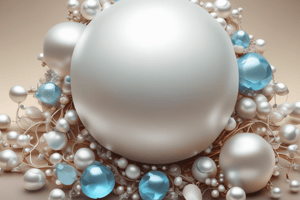Podcast
Questions and Answers
What is the basic definition of a pearl?
What is the basic definition of a pearl?
A pearl is an organic gemstone formed within mollusks, primarily oysters and mussels.
What initiates the formation of a pearl in a mollusk?
What initiates the formation of a pearl in a mollusk?
The formation is initiated when an irritant, such as sand or a parasite, enters the mollusk.
What substance does a mollusk secrete to form a pearl?
What substance does a mollusk secrete to form a pearl?
A mollusk secretes nacre, also known as mother-of-pearl, to coat the irritant.
What are the two main types of pearls?
What are the two main types of pearls?
List one factor that influences the quality of a pearl.
List one factor that influences the quality of a pearl.
What type of mollusks typically produce freshwater pearls?
What type of mollusks typically produce freshwater pearls?
Why are pearls economically important?
Why are pearls economically important?
What is one environmental concern related to pearl farming?
What is one environmental concern related to pearl farming?
How does the size of a pearl generally affect its value?
How does the size of a pearl generally affect its value?
Flashcards are hidden until you start studying
Study Notes
Pearl Formation
-
Definition:
- Pearls are organic gemstones formed within mollusks, primarily oysters and mussels.
-
Process of Formation:
-
Irritant Entry:
- An irritant (e.g., sand, parasite) enters the mollusk.
-
Nacre Secretion:
- The mollusk responds by secreting layers of nacre (mother-of-pearl) to coat the irritant.
-
Layering:
- Over time, the mollusk deposits successive layers of nacre around the irritant, forming a pearl.
-
Maturation:
- This process can take several months to years, depending on the species and environmental conditions.
-
-
Types of Pearls:
- Natural Pearls:
- Formed without human intervention.
- Cultured Pearls:
- Formed with human assistance; a nucleus is intentionally introduced into the mollusk.
- Natural Pearls:
-
Factors Influencing Quality:
- Luster: Reflective quality of the pearl's surface.
- Color: Can vary widely; influenced by the mollusk type.
- Shape: Ranges from perfectly round to baroque; symmetry matters.
- Size: Generally, larger pearls are more valuable.
-
Mollusk Types:
- Saltwater Oysters: Produce pearls like Akoya, Tahitian, and South Sea pearls.
- Freshwater Mussels: Typically produce cheaper, more varied pearls.
-
Economic Importance:
- Pearls are valuable in jewelry markets and have cultural significance in various societies.
-
Environmental Impact:
- Pearling can impact ocean ecosystems, and sustainable practices are essential for conservation.
Pearl Formation
- Pearls are organic gemstones created inside mollusks, particularly oysters and mussels.
- Pearls form when an irritant, such as sand or a parasite, enters a mollusk.
- The mollusk then secretes layers of nacre, also known as mother-of-pearl, to coat the irritant.
- Over time, these nacre layers build up, creating a pearl.
- The time it takes for a pearl to form can range from several months to years, depending on the mollusk species and its environment.
- Natural pearls form without any human interference.
- Cultured pearls are formed with human assistance, involving the introduction of a nucleus into the mollusk.
- The quality of a pearl is influenced by factors like luster, color, shape, size, and the type of mollusk that produced it.
- Luster refers to the reflection quality of a pearl's surface.
- Color can vary significantly, depending on the mollusk species.
- Pearl shapes range from perfectly round to baroque, with symmetry playing a role in value.
- Larger pearls are generally more valuable.
- Saltwater oysters produce pearls such as Akoya, Tahitian, and South Sea pearls.
- Freshwater mussels typically produce less expensive and more varied pearls.
- Pearls have significant economic value in the jewelry market and hold cultural significance in many societies.
- Pearling practices can affect ocean ecosystems, making sustainable practices crucial for conservation.
Studying That Suits You
Use AI to generate personalized quizzes and flashcards to suit your learning preferences.



